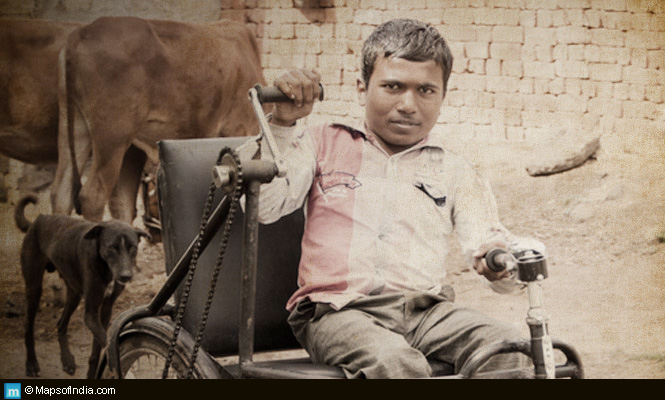 A disability could be the outcome of an impairment which may be physical, cognitive, mental, sensory, emotional, developmental, or some combination of these, or rarely due to a predominance of special abilities. A disability may be present from birth, or occur during a person’s lifetime. However, when one thinks of names like Einstein, Helen Keller, Stephen Hawking, and closer home, names like Sudha Chandran, Arunima Sinha (first amputee to scale the Mount Everest), Rajendra Singh Rahelu (polio-stricken and silver medallist in Commonwealth Games 2014), one realises that these are not just disabled people, they are, in fact, people with very special abilities.
A disability could be the outcome of an impairment which may be physical, cognitive, mental, sensory, emotional, developmental, or some combination of these, or rarely due to a predominance of special abilities. A disability may be present from birth, or occur during a person’s lifetime. However, when one thinks of names like Einstein, Helen Keller, Stephen Hawking, and closer home, names like Sudha Chandran, Arunima Sinha (first amputee to scale the Mount Everest), Rajendra Singh Rahelu (polio-stricken and silver medallist in Commonwealth Games 2014), one realises that these are not just disabled people, they are, in fact, people with very special abilities.
As per the 2011 census conducted in India, disability includes the following physical and cognitive impairments:
- In seeing
- In hearing
- In speech
- In movement
- Mental retardation
- Mental illness
- Multiple disability
- Others (to include people with disabilities not included in the list.
The census shows that the population of disabled people has increased by 22.4% from 2.19 crore in 2001 to 2.68 crore in 2011. The increase is more in the rural areas and in Maharashtra, Andhra Pradesh, Odisha, Jammu and Kashmir and Sikkim, the disabled account for 2.5% of the total population.
The curse of being discriminated
As per the census, a significant population with disabilities in India lives in the rural areas. In rural areas, people with disabilities are ostracized and not included in the society. They are denied basic education or vocational training and thus do not have any scope of employment. Lack of rehabilitation turns them poverty-stricken and the disabled people in the rural areas are therefore caught up in a vicious cycle of disability and poverty. The exclusion of disabled people also has a negative impact on the community as a whole. It is time to make inclusive policies with action on the ground to stop further discrimination.
Things may not be as bad in the urban area, but there are cases where the disabled are harassed and discriminated, like the disability discrimination row over Jet Airways failures to provide for passengers with reduced mobility. Unlike in foreign countries, buildings in India do not cater for the requirements of the disabled, with no provisions for ramps for the wheelchairs. It is as though the society has become visually impaired, turning a blind eye towards them.
The disability Act
India’s disability Act of 1995 provides various facilities for both children and adults with disabilities in the country. They are:
- Children with disabilities have the right to free education until they reach the age of eighteen in schools that are integrated or in special schools.
- Children with disabilities have the right to appropriate transportation, removal of architectural barriers, as well as the restructuring of curriculum and modifications in the examination system.
- Scholarships, uniforms, books and teaching materials are all provided to children with disabilities for free.
- Children with disabilities have access to special schools that are equipped with vocational training facilities, and non-formal education. India provides training institutions for teachers in order to establish manpower.
- Parents of children with disabilities in the nation can move to an appropriate court for the redress of grievances in regards to their children with disabilities.
- Parents of children with disabilities are required to obtain a ‘disability certificate’ from ‘Office of the Commissioner for Disabilities,’ in order to access the facilities.
- Every ‘panchayat’ is provided funding by the Government in order to build roads, schools and public ramps for people with disabilities.
- Three-percent of all Government jobs in the country are reserved for people with disabilities, and the disability Act includes affirmative action for people with disabilities.
People with disabilities in the country, who are seeking information in regard to the facilities available to them, have to visit the Office of the Commissioner for Disabilities. Should a school refuse admission to a child with a disability, or if a ramp or other means of access is lacking, parents have the option of taking the matter up with the Disabilities Commissioner for redress.
The Government in February, 2014 introduced a Bill in the Rajya Sabha to add to the aforesaid rights and privileges of the disabled in India. The Bill had the following points:
- Respect for inherent dignity, individual autonomy, including the freedom to make one’s own choices, and independence of persons;
- Non-discrimination;
- Full and effective participation and inclusion in society;
- Respect for difference and acceptance of persons with disabilities as part of human diversity and humanity.
Conclusion
It is important for every citizen to realize the need for including the disabled people into the society. One never knows in whom a Stephen Hawking or an Albert Einstein is hidden. As we forge ahead into a brighter and a better world, we need to hold the hands of the disabled people and take them along with us. It is time to make India a discrimination-free and inclusive society where the disabled have the right of space like all others.
It’s time for a better tomorrow.





